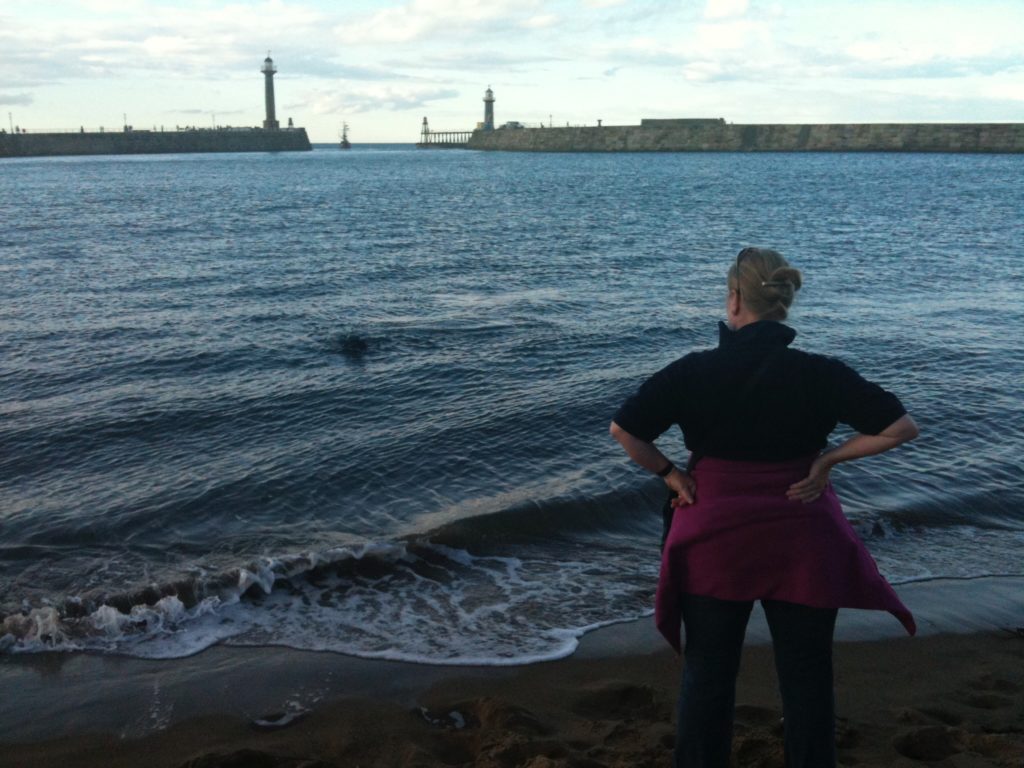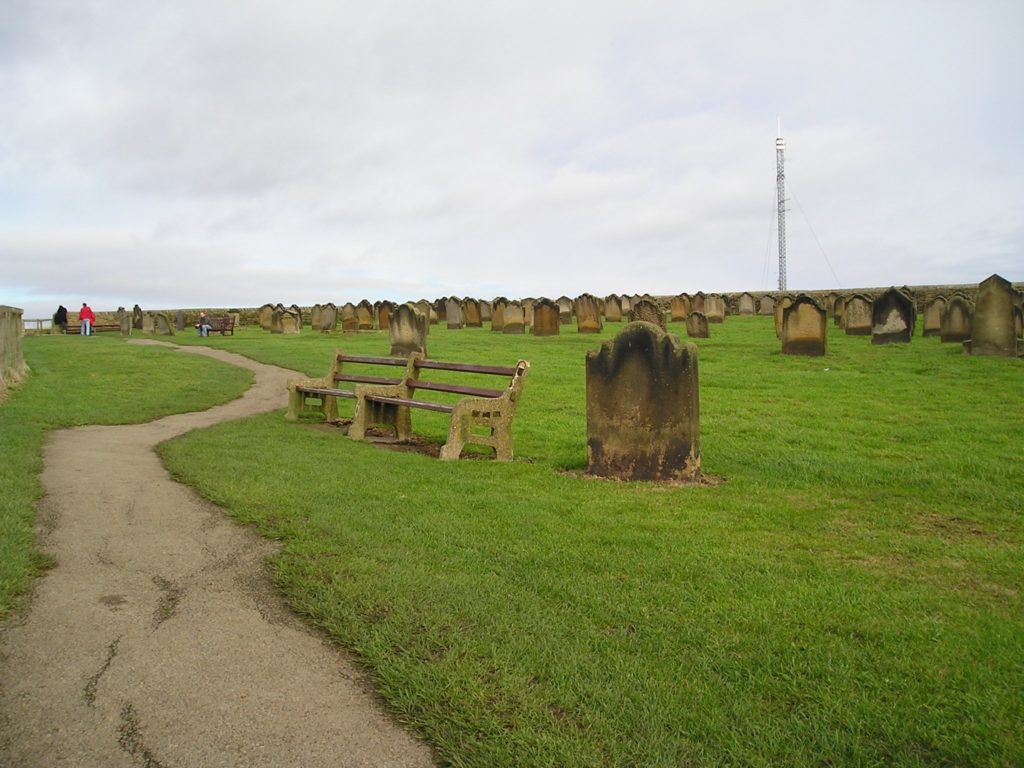Welcome to Part 2 of Psychic Investigator Paul Fitz-George’s guest series “Whitby’s Fascination for the Literati or how Dracula met the Jabberwocky.”
In Part 1 he gave us some background on Whitby and its haunted history. In this post, he talks about Whitby’s influence on Bram Stoker.
Stoker arrived in Whitby in 1890, staying at 6 Royal Crescent which is just off the fashionable North Terrace on Whitby’s west side. He was known to observe the town below and Abbey opposite, from the nearby Royal Hotel’s large windows, possibly smoking a contemplative cigar in one hand with a fine scotch in the other, as he brooded over the movements and motivations of his terrifying creation.
It was when he chose to leave his lair and walk around the vibrant tourist haunt below that he began to bring together the threads he would use to weave his fantastic tale. It was here that he would have observed the well-attired visitors promenading to the sound of the cheerful band on the bandstand, perhaps seeing a Mina here or a Lucy there, as well as sizing up the local men in their seaman’s gear, plucking an obvious Mr Swales from their number. His thoughts would then turn to undead Balkan vampire lords, who he began to imagine roaming Whitby’s streets of the living at night, hunting down the hapless, beautiful and weak. Firstly drinking their life’s blood from their warm quivering throats and finally capturing and imprisoning their tormented souls for eternity. An analysis of Stoker’s time and movements in Whitby, point to several key areas within the town that helped him form the genesis of Dracula’s assault on England.
In 1890, Stoker visited the then Whitby subscription library on the waterfront and borrowed a book titled ‘An Account of the Principalities of Wallachia and Moldavia (1820) by William Wilkinson’, whose contents detailed the exploits of a ferocious Romanian warlord Vlad ?epe?. ?epe?, the scourge and ruthless impaler of the Turks, formed the foundational core of Stoker’s character Dracula, who in his undead state was to terrorise the imaginations and dreams of generations of readers to come.
Gradually then and during his continued meanderings in the town, Stoker began to acquire the facets of this part in the story’s captivating timeline, which would help to fill out and bring to life The Count’s nefarious character so convincingly. The ship that Dracula steals into Whitby on called the Demeter (in Greek mythology, the name of the goddess of the harvest and ironically, in the case of the barren vampires, fertility), actually relates to a real event that occurred around this time.
In the fictional story Dracula’s ship, its crew decimated by his blood lust, is beached on Collier’s Hope near Tate Hill Pier. Metamorphosing into a great hound, Dracula quickly escapes the schooner as it shudders to a halt, leaving its dead captain still lashed to its wheel. Once on the nearby pier, he swiftly bounds up the nearby precipitous staircase known as the 199 steps to the wind-blown graveyard above the town.
The real incident that was used to put together the Count’s unwanted arrival, occurred in October 1885 and involved a Russian schooner called the Dmitry (note the similarity in the name). The story of the ship’s demise was covered by the local paper The Whitby Gazette on the 31st of October 1885, its article stating that the ship had been blown into the port on its journey to England from Narva (present day Estonia). The article reads as follows: –
‘A little later in the afternoon a schooner was descried to the south of the harbour, outside the rocks. Her position was one of great danger; for being evidently unable to beat off, there seemed nothing for it but to be driven among the huge breakers on the scar. Her commander was apparently a man well acquainted with his profession, for with consummate skill he steered his trim little craft before the wind, crossing the rocks by what is known as the ’sledway’ and bringing her in a good position for the harbour mouth.
The piers and the cliffs were thronged with expectant people, and the lifeboat ‘Harriot Forteath’ was got ready for use in case the craft should miss the entrance to the harbour and be driven on shore. When a few hundred yards from the piers she was knocked about considerably by the heavy seas, but on crossing the bar the sea calmed a little and she sailed into smooth water. A cheer broke from the spectators on the pier when they saw her in safety.
Two pilots were in waiting, and at once gave instruction to those on board, but meanwhile the captain not realising the necessity of keeping on her steerage, allowed her to fall off and lowered sail, thus causing the vessel to swing towards the sand on the east side of the harbour. On seeing this danger the anchor was dropped, but they found no hold and she drifted into Collier’s Hope and struck the ground. She purported to be the schooner ’Dmitry’ of Narva, Russia, Captain Sikki, with a crew of seven hands, ballasted with silver sand. During the night of Saturday the men worked incessantly upon her that her masts went by the board and on Sunday morning, she lay high and dry a broken and complete wreck, firmly embedded in the sand.’

The bench that the girls and Mr Swales sit on during the story and on which he is eventually murdered, would probably have been based on one of the several benches existent on the cliff during Stoker’s time. Furthermore, the unfortunate George Cannon’s grave on unhallowed ground (this Church custom was practised right up to 1882 when the Church’s Canon Law changed, but may well have been carried on for a period afterwards) may also have been taken from the presence of a suicide’s grave in that area.
The grave Stoker used would have either been outside the main burial ground and most probably on the graveyard’s north side, where all the benches (more or less) face north and directly out to sea as you look out from the harbour’s mouth. Since Stoker’s time however and due to coastal erosion, the one he probably envisaged as being the one on which the girls and Mr Swales sat, has gone over the cliff a long time ago, though many still ask to this day and much to the local vicar’s consternation, ‘Where’s Dracula’s grave?’

As can be seen then, there was much in Whitby for Stoker to glean, ponder over and use in his fantastic tale.
On the subject of characterisation within the story, Stoker in all probability put together the make up of other characters in the Whitby chapters, from direct contact with its townsfolk.
For example the surname of our brave protagonist Jonathan Harker, is a local one that Stoker probably came across in the town. I couldn’t help but note that the house I bought in nearby Grosmont in the late 1980’s was owned by the Harker family. The lady of the house during the purchase mentioned that her ancestor was a maid in service at Royal Crescent and possibly at the very house that Stoker stayed at. It seem then that vampires and wraiths are something of an occupational hazard to tourists in Whitby, which brings me neatly to my next writing aficionado, Wilkie Collins.
This series will continue in Part 3: Whitby’s Influence on Wilkie Collins. Stay tuned. If you dare…
Got an idea you’d like to submit? We’re always looking for quality infotaining posts about true crime, horror, and the paranormal –or some blend thereof. Visit our Writers Wanted page for submission details. We’d love to have you join our Skeleton Crew!
P.S.
Yes.
That’s the answer to that question we know you’re wondering about. We do pay. Not a lot. Don’t get excited. But we believe in paying writers for their time and energy. You’ll find complete details on the Writers Wanted page.
